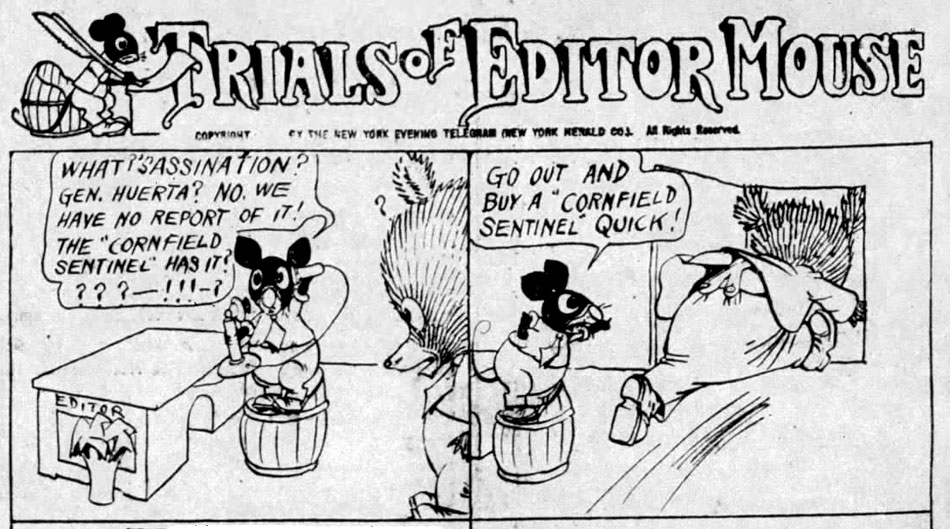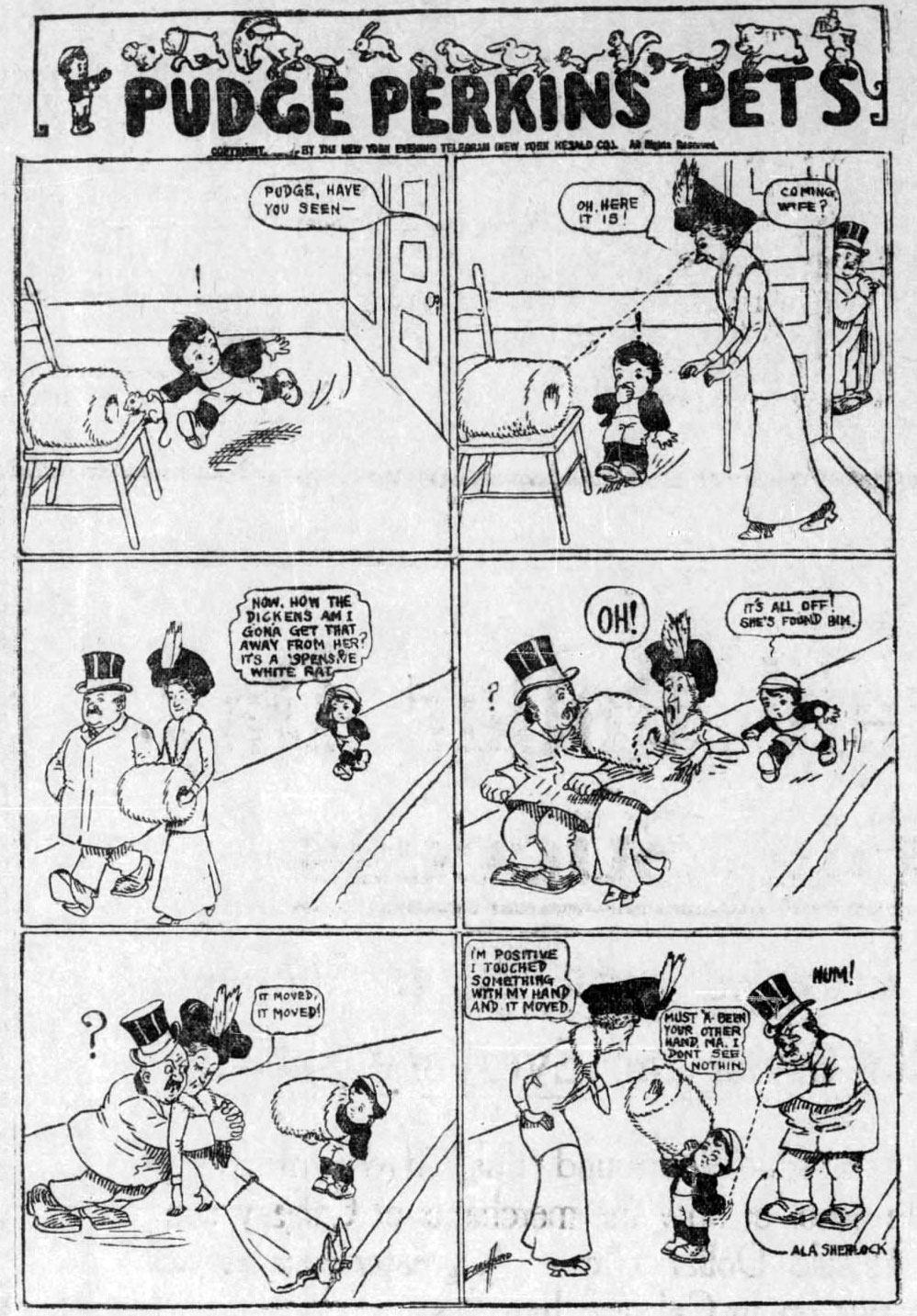'Trials of Editor Mouse' (The Daily Herald, 25 May 1914).
Earl Hurd was an American animator and a pioneer in this art form. He worked for various studios, namely J.R. Bray, Paul Terry, Ub Iwerks and Walt Disney, and as historically important as the patented inventor of cel animation. Hurd was also active as a cartoonist, working for New York newspapers on features like 'Trials of Editor Mouse' (1911-1915) and 'Brick Bodkin's Pa' (1912), and later 'Susie Sunshine' (1927-1929), which was later continued other cartoonists under the titles 'The Boomers' and 'Frankie Doodle'. His own animated cartoon creation for Bray was 'Bobby Bumps' (1915-1925), about a little boy and his dog
Early life and comics career
Earl Oscar Hurd was born in 1880 in Kansas City, Missouri as the son of a grocer. He published his first cartoons in the Kansas City Post, before moving to New York City. By 1904, his work could also be found in The Chicago Journal and the New York newspapers owned by James Gordon Bennett. In 1911, he created two weekday children's comic strips for the New York Evening Telegram. 'Trials of Editor Mouse' (6 May 1911-25 September 1915) was a humor comic about a group of funny animals running a newspaper, and 'Pudge Perkins' Pets' (7 March 1911-14 December 1912) told about the trouble and confusion a little boy caused with his many pet animals. In the following year, he also created a Sunday comic for The New York Herald, 'Brick Bodkin's Pa' (12 May 1912-26 April 1914). These strips were also distributed to other newspapers.
'Pudge Perkins' Pets' (Calgary Herald, 31 May 1913).
Early animation career
In 1915, Hurd made the switch to animation, when he joined J.R. Bray's cartoon studio. There, he created the animated series 'Bobby Bumps' (1915-1925), dealing with a little boy called Bobby and his dog Fido, who get involved in all kinds of mayhem. Continuing in the tradition of his earlier comic strip creation Brick Bodkin, the main inspiration for the series were the actual experiences of the cartoonist's seven-year old son Earl Jr. and his dog. The style was inspired by Richard F. Outcault's newspaper comic 'Buster Brown', which featured similar protagonists. To advertise their animated productions, the Bray Studios also produced a series of newspaper comic strips. Running for only a few months (September-October 1916), the series included strips with the Paul Terry creation 'Farmer Al Falfa', Bray's own 'Colonel Heeza Liar' and Earl Hurd's 'Bobby Bumps'.
While 'Bobby Bumps' is completely forgotten today, it holds historical significance for pioneering cel animation. Up to that point, animators had been forced to redraw every character and background over and over again for each film frame. Hurd got the idea of drawing the characters on a clear sheet of celluloid. He placed them over still backgrounds, which were then photographed. Since it wasn't really necessary to redraw backgrounds all the time - after all they remained the same during each individual scene - all the energy could now be spent on the characters. Cel animation saved a lot of time and revolutionized the still young medium. Until the rise of CGI in the 1990s, nearly all cartoon productions made use of it. In 1914, Bray and Hurd patented it, and made a profit off of it with the Bray-Hurd Processing Co. In 1932, the patent went into the public domain.
In 1917, Hurd was drafted into the U.S. army and served during the First World War. Back in civilian life, he worked for Paul Terry's studio for a year, then rejoined Bray for another year. In 1923, he got the bold idea to start his own animation studio. Unfortunately, Earl Hurd Productions wasn't a success, and in 1925 he had to close down his studio. He returned to Bray once more, but in 1927 left the animation industry for a few years and returned to newspaper cartooning.
Susie Sunshine and other later comics
During the late 1920s, Hurd created a daily comic strip about a not-too-bright flapper girl, 'Susie Sunshine' (1927-7 June 1930). The feature was published in The New York Evening Graphic and distributed by King Features Syndicate, before the Graphic Syndicate took it over. In 1930, Hurd left the comic to Al Zere, who continued it until 1931, after which Dick Richards became the artist, and eventually retitled it to 'The Boomers'. Between 1934 and 1938, the comic was continued by Ben Batsford, this time under the titles 'The Doodle Family' and 'Frankie Doodle'.
Between September and October 1929, Hurd also drew a series of comic strips which poked fun at current events. They had different titles each day and no recurring characters. One of them starred then-U.S. President Herbert Hoover. This lack of a proper way to identify the comic might explain why it failed to catch on.
Return to animation
During the early 1930s, Hurd returned to animation and worked for Ub Iwerks. Iwerks was originally Walt Disney's top animator, but had left Uncle Walt's studio in 1930 to start his own company. Hurd believed Iwerks was the key to Disney's success, but in reality it was the other way around. While Iwerks' cartoons were never very popular, Disney entered a veritable golden age, combining box office revenue with impressive technical improvements. In 1934, Hurd joined Disney instead. He worked as an animator on the 'Mickey Mouse' short 'Two-Gun Mickey' (1934) and made storyboards for the Silly Symphony short 'Elmer Elephant' (1936) and four Pluto cartoons: 'Mother Pluto' (1936), 'Pluto's Quin-puplets' (1937), 'Pantry Pirate' (1940) and 'Pluto's Playmate' (1941). Hurd additionally collaborated on animated features like 'Snow White and the Seven Dwarfs' (1937) and 'Fantasia' (1940).
Death
Although Hurd had seemingly finally found the perfect job, this bliss didn't last long. In 1940, he suddenly died at age 60.
'Believe It Or Not', featuring a guest appearance of U.S. President Herbert Hoover.
Earl Hurd strips on the Stripper's Guide (and his Ink Slinger profile)







